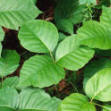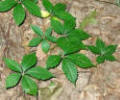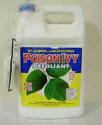Anyone who has ever experienced the blisters,
swelling, and extreme itching from an unfortunate encounter with poison
ivy, learns quickly to avoid it whenever possible. It grows in
non-cultivated sites, such as along stream banks, roadways, fence rows,
and woodlands. It can even make an appearance in your ornamental shrub
or perennial borders. Therefore, knowing how to identify and control it
are the best defenses against accidental contact.
Identification
 The best way to identify poison ivy (Rhus radicans)
is by its characteristic compound leaf consisting of three leaflets.
The leaflets are two to four inches long, dull or glossy green with pointed
tips. The middle leaflet is generally larger than the two laterals. The
margins of the leaflets are variable, appearing irregularly toothed, lobed, or
smooth. The leaves are positioned alternately on the stems.
The best way to identify poison ivy (Rhus radicans)
is by its characteristic compound leaf consisting of three leaflets.
The leaflets are two to four inches long, dull or glossy green with pointed
tips. The middle leaflet is generally larger than the two laterals. The
margins of the leaflets are variable, appearing irregularly toothed, lobed, or
smooth. The leaves are positioned alternately on the stems.
 In contrast, Virginia Creeper
(Parthenocissus
quinquefolia), a
non-poisonous vine often
mistaken for poison ivy, has five leaflets radiating from one point of
attachment. Poison ivy can be found in one of three forms; as an erect woody
shrub, a trailing shrub running along the ground, or a woody vine. The vine is
usually seen growing on trees or other objects for support. It has aerial
roots along the stem that give it the appearance of a "fuzzy rope."
Yellowish-green flowers occur in compact clusters in leaf axil, and are
produced in June or July.
In contrast, Virginia Creeper
(Parthenocissus
quinquefolia), a
non-poisonous vine often
mistaken for poison ivy, has five leaflets radiating from one point of
attachment. Poison ivy can be found in one of three forms; as an erect woody
shrub, a trailing shrub running along the ground, or a woody vine. The vine is
usually seen growing on trees or other objects for support. It has aerial
roots along the stem that give it the appearance of a "fuzzy rope."
Yellowish-green flowers occur in compact clusters in leaf axil, and are
produced in June or July.
The waxy, berry-like fruit is grayish-white, with distinct
lines marking the outer surface, and is about three-sixteenths of an inch in
diameter.
Poison ivy is poisonous all year around. The oil in the
leaves, stems, roots and fruit are what cause the skin irritation. Although
contact with the plant is the common method of poisoning, handling clothing,
tools, objects or animals that have become contaminated with the oil may also
result in spreading the problem to people.
 Be aware that, even though you may have seemed to be immune
to poison ivy in the past, the skin reaction may develop later in life.
Therefore, care should always be taken when working in or near poison ivy.
Be aware that, even though you may have seemed to be immune
to poison ivy in the past, the skin reaction may develop later in life.
Therefore, care should always be taken when working in or near poison ivy.
Control
Options
There are three methods that can be effective in
eradicating poison ivy in ornamental beds. They include hand pulling or
grubbing; severing the vine and then treating the regrowth with an herbicide;
or applying an herbicide to individual leaflets.
Hand pulling should not be done by people who are sensitive
to poison. If used, this method is most successful when the soil is moist. The
roots can be dug and pulled out in long pieces. Care should be taken to remove
the entire root because the plant can re-sprout from sections of root left in
the ground. One method of disposing of the plant material that has been dug
out is to bury it in a hole several feet beneath the surface of the soil.
a hole several feet beneath the surface of the soil.
Avoid skin contact by wearing gloves while you work and
washing clothing and gloves immediately after. The washing machine should be
rinsed thoroughly afterward to eliminate the possibility of contaminating
other clothing.
Vines growing on trees can be difficult to pull out of the
ground because their roots may be entangled with the tree's roots. Sever the
vine at the base and carefully pull it out of the tree.
Glyphosate (e.g.,
Roundup or Ortho's Kleeraway Grass & Weed Killer), a non-selective,
translocated herbicide, can be applied to the new shoots that will soon emerge
from the base of the old plant. This herbicide is most effective if applied to
actively growing foliage of young vines two weeks on either side of full
bloom, in early summer.
 Another herbicide that may be used is triclopyr (e.g..,
Ortho's Brush-B-Gone Poison Ivy Killer). Poison ivy is difficult to control
even with herbicides. Neither glyphosate nor triclopyr will provide complete
control from a single application, and repeat applications to treat regrowth
may be necessary. Other herbicide brands or formulations may be found at your
local garden center. Be sure to read the label to ensure that poison ivy is
listed on the label, then follow the manufacturer's directions.
Another herbicide that may be used is triclopyr (e.g..,
Ortho's Brush-B-Gone Poison Ivy Killer). Poison ivy is difficult to control
even with herbicides. Neither glyphosate nor triclopyr will provide complete
control from a single application, and repeat applications to treat regrowth
may be necessary. Other herbicide brands or formulations may be found at your
local garden center. Be sure to read the label to ensure that poison ivy is
listed on the label, then follow the manufacturer's directions.
When poison ivy is found in the midst of your prized
ornamental plants, special care should be taken to eliminate it. Paint the
individual leaflets with a non-selective herbicide like glyphosate to avoid
harming desirable plants.
Things to Know
The blistering rash caused by poison ivy is the direct
result of contact with the oily toxicant, known as "urushiol."
Urushiol is found in resin ducts within the plant's
phloem. These ducts are
found throughout the plant, including the roots, stems, bark, leaflets and
certain flower parts. The plant has to be crushed, broken, or in some way
injured to release the resin. The injury may be something as little as an
insect chewing on the plant.
Once urushiol is released, it can find its way to your skin
by direct contact with the plant and then spread by touching other parts of
the body. Because the sticky, oily substance is easily transmitted, there are
indirect ways to contact it, for instance, from the fur of the family pet,
garden tools, garden gloves, clothing, golf balls or other objects that have
come in contact with an injured plant. Contrary to popular belief, the rash
from poison ivy cannot be transmitted from touching the oozing blisters.
 If you know you have contacted poison ivy, wash the area as
soon as possible with soap and cool water. Warm water may cause the resin to
penetrate the skin faster. Because urushiol can penetrate in a matter of
minutes, you may still get a rash, but at least you have contained the
infected area. A visible reaction, redness and swelling may be apparent within
12 to 24 hours. Contact your family physician or pharmacist for
recommendations for effective non-prescription medication.
If you know you have contacted poison ivy, wash the area as
soon as possible with soap and cool water. Warm water may cause the resin to
penetrate the skin faster. Because urushiol can penetrate in a matter of
minutes, you may still get a rash, but at least you have contained the
infected area. A visible reaction, redness and swelling may be apparent within
12 to 24 hours. Contact your family physician or pharmacist for
recommendations for effective non-prescription medication.
One additional caution is that people can contract a rash
by exposure to smoke of burning poison ivy; be careful not to burn wood with
the poison ivy vine attached to it. Take extreme caution to avoid inhaling
smoke or contact of smoke with skin and clothing.



